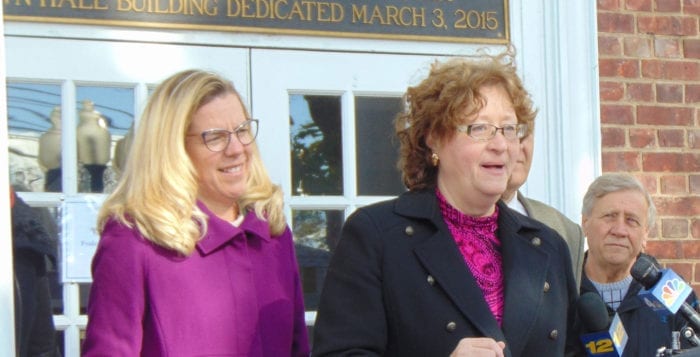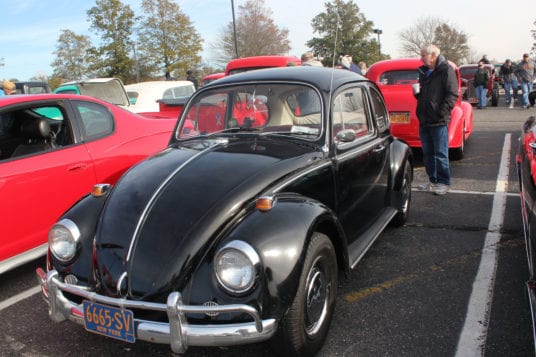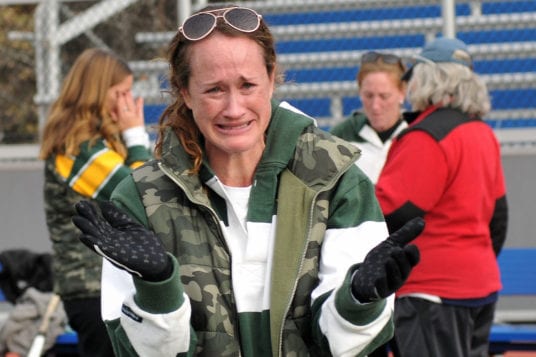Ward Melville’s swim team may have thought it was a rebuilding year, but the Patriots proved they’re faster builders than some might have expected.
After claiming the Suffolk County crown 23 years in a row, the Patriots had placed fourth and fifth at the last two county meets. This year, Ward Melville returned to form, taking home the League II title with a perfect 6-0 record, and retrieving the county championship at Suffolk County Community College’s Brentwood campus Nov. 4 with 269 points, well ahead of Connetquot with 231 points and Northport-Commack with 225.
“I don’t think going into the season we were looking at a possible county championship to be honest,” Ward Melville head coach Chris Gordon said. “We have a very young team and we thought we were rebuilding, but these girls surprised me. We still had depth, which has always been a team strength at Ward Melville, but some of these young girls shined.”
The team’s 200-yard medley relay opened the meet and finished first in 1 minute, 47.86 seconds to beat a 2012 school record. First off the block was senior Victoria Bogdanski.
“We have a very young team and we thought we were rebuilding, but these girls surprised me.”
—Chris Gordon
“I just thought about trying my best and being there for my team,” she said. “We didn’t know we were close to the record, so once we finished the race, we were all so excited. We all had this motivation and excitement that carried through the meet.”
Riley Gavigan, Sydney Boals and Kaitlyn Ehlers finished out the relay with personal-best times. Gavigan said she too was only thinking about her team.
“I wanted to score points, so I was going as fast as I could,” she said. “I knew I wouldn’t just let down myself, I’d be letting down my whole team. We had to be in the right mindset, and we got each other pumped and ready to win.”
Gavigan qualified for three individual events, the 100 breaststroke, 100 backstroke and 200 individual medley but could only compete in two, forgoing the backstroke.
The sophomore placed second in both, finishing the individual medley in 2:08.22 and breaststroke in a school-record time of 1:04.98, just a hair off first-place finisher Margaret Purcell of Southampton, who won in 1:04.34. Gavigan said she was not expecting to break a Ward Melville record that had stood since 1990 in the individual medley, the only record Gordon had not seen broken during his tenure.
“I want to improve every year,” she said. “So heading into the meet I had tunnel vision. I was focused on myself and not everyone else around me.”
Sydney’s not the kind that backs down — she’s no wilting flower, she likes to meet the challenge and she wants to see the best swimmer. Riley is quieter, not as vocally out there, but she works hard and leads by example.”
— Chris Gordon
Boals qualified to compete in four events — the 100 and 200 freestyles, 200 individual medley and 100 breaststroke — deciding to take part in both freestyles. She placed first in the 100 in 53.13 seconds and second in the 200 in 1:54.14.
“I was shocked I won the 100 freestyle — those girls were a lot older than me,” she said. “I’m usually a mid-distance competitor, so I was excited to get that time.”
She broke a 2009 record in the 100 freestyle at the league meet and outdid her time on the county stage. She said it only motivates her to dig deeper.
“We knew we had to show we were ready and we weren’t afraid of losing,” Boals said. “Now I know I can get even faster than I am now.”
Gordon said Boals and Gavigan mean a lot to the team, and noted their impact on the other girls.
“They’re both mentally tough kids and they like to compete and they like to race,” he said. “Sydney’s not the kind that backs down — she’s no wilting flower, she likes to meet the challenge and she wants to see the best swimmer. Riley is quieter, not as vocally out there, but she works hard and leads by example. Whatever I ask her to do, there’s never a problem. It’s never an issue.”
Ward Melville’s 400 freestyle relay team, which comprised Gavigan, Boals, Ehlers and Kylie Kramer, also qualified. The quartet finished third with a time of 3:40.13. Ehlers also finished ninth in the 100 butterfly; Kramer finished sixth in the 500 freestyle; and the 200 freestyle of Kramer, Hope Farrell, Frances Clever and Sophia Swanson finished third in 1:45.02. Bogdanski reached the finish line eighth in the 100 backstroke.
“We had 15 girls make the state qualifying meet, and 23 out of the 27 spots that we competed in we had best times or best dive scores.”
— Chris Gordon
“We had 15 girls make the state qualifying meet, and 23 out of the 27 spots that we competed in we had best times or best dive scores,” Gordon said. “At this point in the season, for them to be swimming as fast as they are and as young as they are, it’s exciting. We will be graduating 10 or 12 seniors, but right now we’re gathering steam and all of the sudden everyone is dropping time and everyone is doing really well.”
The season started off with a bump in the road for the Patriots. Ward Melville lost its opening nonleague meet to a tough Connetquot team, now the county runner-up for the last three seasons, but bounced back to top rival Half Hollow Hills, the defending county champion from last year.
“We worked our hearts out and tried to do our best,” Boals said. “We wanted the seniors to leave with a county championship. We wanted them to have fun and coach to be proud and once we beat Half Hollow Hills and we won the league, we knew we had counties in the bag.”
Gavigan said the momentum will propel the team toward success this weekend in the state finals Nov. 17 and 18 at Ithaca College.
“We were the No. 3 seed heading into counties, so it was good to win and show the other teams that we’re right there with them,” she said. “We’re in the right mindset to place well at states.”
If the county meet was any indication, Gordon said, the girls are peaking at the right time.
“They work very hard, they get along very well in and out of the pool and they’re just a great bunch of girls,” he said. “Some of their siblings have been past members of the team, so there’s some legacy there and they take this seriously. They’re very dedicated, which I appreciate. I’m hoping everyone has a little more left in the tank to go a little faster this weekend.”












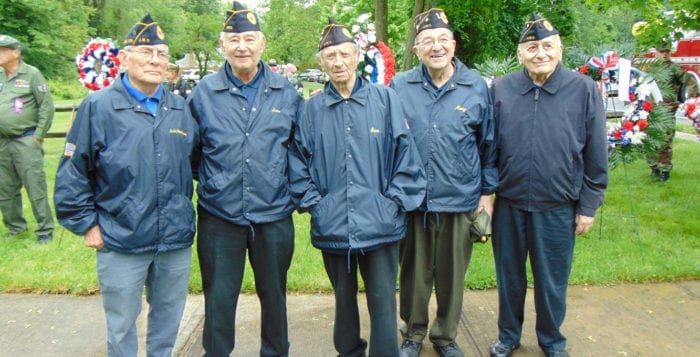
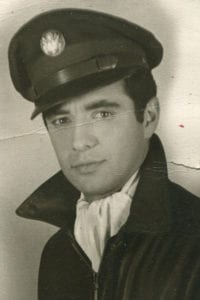
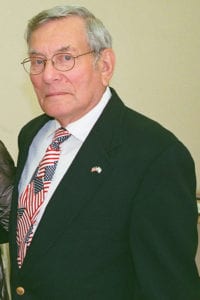
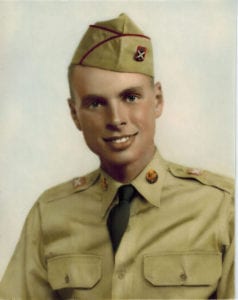

 Linda Ronstadt’s singing career was quite diversified. Beginning with her work as lead vocalist for the folk-rock group Stone Poneys in the mid-1960s (“Different Drum” scored high on the ratings charts), Ronstadt pursued country, alt-country, country rock, pop rock, Latin and classic jazz genres. Along the way, she put together the band that became the Eagles, won a dozen Grammy Awards and was christened the “Queen of Country Rock.”
Linda Ronstadt’s singing career was quite diversified. Beginning with her work as lead vocalist for the folk-rock group Stone Poneys in the mid-1960s (“Different Drum” scored high on the ratings charts), Ronstadt pursued country, alt-country, country rock, pop rock, Latin and classic jazz genres. Along the way, she put together the band that became the Eagles, won a dozen Grammy Awards and was christened the “Queen of Country Rock.”
 Brookhaven Highway Superintendent Dan Losquadro (R) invites high school seniors to apply for one of two $500 Highway Superintendent’s Association scholarships. Applicants should submit a cover letter and high school transcript, with a 400-word maximum essay about why they plan to pursue a career in engineering. Applications should be submitted to
Brookhaven Highway Superintendent Dan Losquadro (R) invites high school seniors to apply for one of two $500 Highway Superintendent’s Association scholarships. Applicants should submit a cover letter and high school transcript, with a 400-word maximum essay about why they plan to pursue a career in engineering. Applications should be submitted to 


